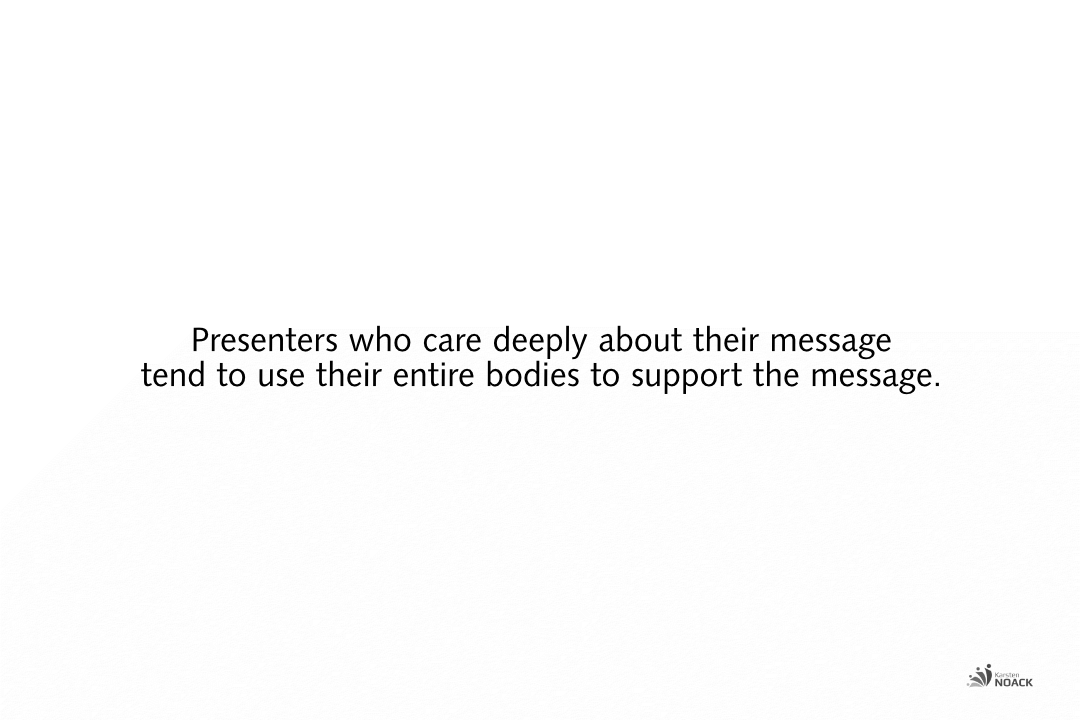17 tips for facial expressions in speeches and presentations
What public speakers should know about facial expressions
The importance of facial expressions in public speaking
When the topic of body language appears in presentation skills training, the question comes up “Where to put my hands while speaking?”
Mimic is discussed rarely, if at all, with the hint of having a smile on your face. This is a pity because facial expressions can support the message. When facial expressions aren’t right, they can cause damage. What does not fit the personality and role of the speaker is unintentionally funny, damages credibility, and distracts.
This article deals with what it is worth paying attention to as a speaker concerning facial expressions.
Overview
Body language, facial expressions, and public speaking
In addition to the content of the speech, as a verbal part, the way of presentation and the non-verbal behavior are of particular importance. These include gestures, eye contact, eye direction, body tension, leg posture, volume, intonation, and, often forgotten, pauses. Pauses before a message produce tension and after a message, they let the message work. In modern rhetoric, facial expressions have become less important than in the past. A facial expression that is too pronounced quickly has a theatrical and posed effect on the audience.
So facial expressions are no longer important?
Mimic is important because public speakers who want to convince have to be authentic. And that includes lively facial expressions. Instead of orienting the facial expressions to Asian theater masks or the pantomime from the pedestrian zone, Method-Acting delivers better results. If you mean what you say, this also includes the corresponding emotional states. If you experience inwardly with all your senses what you verbalize, then your face provides the appropriate facial expression anyway. At least as long as you haven’t stopped it with nerve poison against wrinkles.
Leave that deadpan expression to poker players and some politicians. A good presenter realizes that appropriate facial expressions are a significant part of effective communication. Facial expressions are often the key determinant of the meaning behind the message. The audience is watching a speaker’s face during a presentation. When you speak, your face tells more clearly than any other part of your body about your attitudes, feelings, and emotions.
17 tips for facial expressions in your speeches and presentations
Your impact as a speaker depends heavily on your body language. You probably have control over the words you speak, are you sure you have control over what you say with your body language?
1. Authentic, authentic, authentic
Effective body language supports the message and conveys a strong image of the speaker. Anything that does not fit the personality and role of a public speaker and the message will unintentionally appear funny, damage credibility, and distract from the content and message. Those who mean what they say can automatically display the appropriate facial expressions. This is a frequent topic in my presentation training. Few speakers know how they affect the audience. Professional analysis is very revealing here.
2. Smiling is contagious
Unfortunately, many people lose their lively facial expressions under the pressure of speaking in front of an audience. Their faces solidify into a mask. Free your face right at the beginning. For example, when you are welcoming the audience, smile!
With a smile or even a laugh, it is easier to build a bridge with other people. This looks open and friendly. A real smile comes from within and is based on the right mental attitude and not on a mask. Such a permanent grin looks different from a real smile, which is called a Duchenne smile. The Duchenne smile is named after Guillaume Duchenne, a French anatomist who studied many expressions of emotion, focusing on the smile of pure enjoyment. He identified the facial movements that make this genuine smile different from artificial types of smiles. A Duchenne smile is a natural smile of enjoyment, made by contracting the zygomatic major muscle and the orbicularis oculi muscle. In my words; the mouth, the eyes, and the wrinkles around the eyes are involved, and the smile, the cheeks lifting.
3. Emotions
It is the presenter’s connection to the words that can bring them to life for the audience. Experience inwardly intensively what you want to convey, and the facial expressions will reflect it. Less is more! Please do not grimace.
4. Lead with your gaze
The audience will register where you’re looking. In this way, you can direct the attention of the audience with your gaze. Look where the audience should look.
And be careful with misunderstandings. If you keep looking at the door, it will look as if you would like to escape.
5. Eye contact is connecting
If they don’t fit, they can undermine any of your words.
Good speakers know how important facial expressions are. Effective presenters engage one person at a time, focusing long enough to complete a natural phrase and watch it sink in for a moment. With a smile, they convey appreciation to the audience.
Keep looking at all faces, and be attentive. Return a smile. Use clues such as a frown as an occasion to repeat or inquire about a statement in other words.
6. Pulling up the corners of your mouth on one side
Some facial expressions can irritate. One-sided lifting of the corners of the mouth can be interpreted as a sign of superiority, and the speaker is then accused of arrogance or cynicism.
7. Enduring smile
A permanent smile seems artificial, complacent, or even debilitating. Speakers don’t do themselves any favors.
Such behavior is reminiscent of bad show presenters or used car salesmen from US films. If you smile without a break, you make your counterpart suspicious. Beware of bad facial expressions, i.e. a superimposed smile.
If there are moments during your speech when you want to make the audience think, then that doesn’t fit. When you put on an artificial smile, nobody takes you seriously.
8. A tense jaw
Someone who presses their teeth vigorously against each other may look angry and aggressive, or at least cramped.
9. Smiling and showing teeth
What is more common in the USA is more irritating in Germany, for example, than piranha smiles. Superficiality and an unfair sales mentality are easily assumed.
10. Grasping the nose or the mouth
Do not touch your nose, mouth, or chin during your speech. This is a classic sign of insecurity and is quickly perceived as negative by your audience.
Since Pinocchio this has been considered a sign of lies, and why should you voluntarily sow doubt?
11. Other delicate facial expressions
In my articles, Body Language Soothes or harms in delicate situations and 12 tips on how to promote confidence through body language, you will find advice on how body language can help and how it can hurt.
12. Adapt your facial expressions to the size of the group.
As your audience grows, your facial expressions should become more pronounced. If the audience in the last row is not able to read your face, your facial expression will be perceived as a neutral expression and thus as your lack of interest.
13. Explore the effect of facial expressions
The facial expression usually has a small part in the presentation, which is why its role tends to be underestimated. It plays an important role in convincing the speaker and the message. It is worth exploring the impact.
Using all the various muscles that precisely control the mouth, lips, eyes, nose, forehead, and jaw, the human face is estimated to be capable of more than 10,000 different expressions. Explore different ways to use facial expressions. Start with the most common facial expressions and emotions.
There are seven universally recognized emotions shown through facial expressions:
- anger
- disgust
- contempt
- fear
- happiness
- sadness
- surprise
Regardless of culture, these expressions are the same all over the world. They may differ in intensity.
14. Observe your audience
Just as your facial expressions provide insight into your emotions, your audience’s facial expressions provide insight into their emotional world.
Read the facial expressions of your audience. If the audience’s expressions are expressionless, for example, there is a possibility that they are intellectually elsewhere because they are bored. Or their facial expressions convey joy and excitement, or they are eagerly receptive or…
By reading your audience’s facial expressions, you are better able to make spontaneous decisions and adjustments to capture attention.
15. Using a lectern or manuscript
Wherever your speech manuscript is located, whether as a pile of paper on the lectern or as key point cards in your hand, always avoid looking at the notes all the time. Learn from me how to keep in touch with the audience.
16. Practice, practice, practice
As with any presentation skill, facial expression requires practice to develop it to be both authentic and effective. Presenters who care deeply about their message tend to use their entire bodies to support the message.
Practice your presentation and the things you have experienced with me in front of a mirror to concentrate exclusively on your facial expressions during a rehearsal. While practicing in front of the mirror, see if your facial expressions convey the mood you want to create. If your face isn’t showing any emotion, stop, refocus, and do it again. This will help you to explore your expression playfully. The best way to do this is with professional support.
17. Support
As a professional speech coach, I will not practice masks with you but will point out potential misunderstandings and promote corresponding situations from within.
Preparation of important speeches and presentations
Those who do not speak are not heard, and even those who speak up are not always successful. There are a few more steps that need to be mastered.
Do you want to convince with your message and also as a personality? Then I will help you to prepare your speeches and presentations. You determine the scope. At least, I recommend a test run with professional feedback for you and your message. Then you will know how you and your content are perceived, what you should do, and what you should leave out, where there is potential. Why do you want to get such helpful feedback so late after your real performance? Then it is too late for adjustments. Benefit from the advantage. My definition of luck: Preparation meets opportunity.
You can best estimate for yourself where the effort is worthwhile concerning the expected benefit. Here you will find the fees for my support (communication, psychology, language, structure, voice, body language, storytelling, rhetorical means, media such as PowerPoint and Co., etc.)
You are not in Berlin right now? Then choose meetings with me via telephone or video support. Whereby, there are quite good reasons for a trip to Berlin.
By the way, many people suffer from such intense stage fright in front of an audience, and therefore their performance lags behind their possibilities. Too bad, because with my help performance in a good condition is possible. Just in case...
A good start: Professional feedback with suggestions for improvement
How persuasive are you and your messages in speeches and presentations? How good are you at the 111+ most important presentation skills? I have been analyzing speeches since 1998. After evaluating 14,375 speeches and presentations, and numerous mistakes of my own, most of which I only discovered after a delay, I can tell you exactly what works with which audience. Let me give you the feedback that will help you get ahead. You will receive essential feedback and recommendations, as well as the impulses you need to persuade your audience in concrete situations.
Are you interested? If so, here is how to get helpful feedback with recommendations for improving your speeches and presentations.
Just ask me personally
Please post any questions that may be of interest to other readers in the comments. Looking for professional help?
If you are interested in coaching, training or consulting, if you have organizational questions, or if you want to make an appointment, you can reach me best via this contact form (you can choose whether you want to enter your personal data) or via e-mail (mail@karstennoack.com). The privacy policy can be found here.
Transparency is important. That is why you will find answers to frequently asked questions already here, for example about me (profile), the services, the fees and getting to know me. If you like what you see, I look forward to working with you.
Remarks:
In the address bar of your browser, the URL should begin with "https://www.karstennoack.com/...". This indicates a secure connection (SSL). Whether you enter your real name is up to you.
Related articles
- What may cost the preparation of a presentation, which effort is justified?
- Speak and read body language. How to convince your audience!
- Presentation prep in Berlin and online with video in English and German
- Professional impact analysis: How are you perceived by other people?
- Trustworthy body language. Trust, dignity, and body language.
- Body language: What can be read from the eyes? Not only wishes!
- A travel companion for heroes
3 Comments
Submit a Comment

Present the benefits in the beginning of your pitch
There are many strategies to consider in opening your pitch. Think about it twice, because those first minutes can make or break you.
Professional impact analysis: How are you perceived by other people?
How do you actually affect people in conversations, speeches and presentations, in interviews? Professional feedback helps. What insights does an impact analysis offer you?
Public speaking: Keeping it simple doesn’t mean you’re stupid
One should choose the simplest explanation of a phenomenon, the one that requires the fewest leaps of logic. The more complex something is, the easier we should explain it.
Five fingers for a structured speech. Five-finger speech structure.
The five-finger speech structure step by step. Systematically build up statements, whether for speeches, presentations, or discussions.
Speech anxiety as an obstacle for your career
Stage fright is a common experience, most people know the queasy feeling as well as the sweaty fingers, and that is already unpleasant enough. But what if speech anxiety becomes a career killer?
Just read out speech manuscripts …
There are good speechwriters. But what value has the best manuscript, when the performance is uncharitable? Unfortunately, in the end, the cupcakes are the highlight! An important speech deserves preparation, rehearsals, …
Create an excellent speech or presentation as a masterpiece
Create an excellent speech or presentation. It will bring you forward as a presenter. Every speaker should make a brilliant speech at least once in his life. The effect goes far beyond the event because the experience becomes a mental reference. Such an experience will change you as a speaker. Create your rhetorical masterpiece. Here is how to do it.
Beware of manipulation: Intentional mirroring in conversations
Intentional mirroring is the deliberate imitation of other people to make them feel good. It serves to promote rapport and can also be used against the interests of the mirrored.
Being right at all costs. The price we pay for needing to be right.
Persuading without arguments, assertiveness, winning without consideration, knockout by nasty tricks, black magic, manipulating. It is a coveted feeling to be right.
Grounding for presence and confidence in speeches and presentations
Use grounding for presence and a feeling confident in speeches and presentations. More than just a remedy for stage fright.
Body language: What can actually be read from the eyes? Not only wishes!
What can be read from the eyes? More than wishes! The eyes have a big part in human facial expressions. There is a reason why the eyes are called the mirror of the soul. They reveal a lot about our feelings and thoughts, no matter if we want it or not. Eyes can smile, radiate joy, permeate, agree, question, doubt or reject. Learn to read body language.
15 tips on how to stand up for your conviction: Be brave, speak up!
Some people have an opinion that deserves attention. Often, however, this opinion is not heard. Then it is time to decide whether to keep it that way or to share the point of view more clearly with others. Not everyone dares this step. What about you?
This article is a short excerpt from the more comprehensive course materials my clients receive in group or individual training or coaching.
Published: June 27, 2019
Author: Karsten Noack
Revision: October 6, 2021
Translation: ./.
German version: https://www.karstennoack.de/rhetorik-mimik-koerpersprache/
K:
H:
T: RR
#124710












Those are many factors.
You make an important point that if the subject you are speaking on does not excite you then it will not excite the audience. Listening to a speaker talks about something and you can tell that they have no passion, it will be incredibly difficult to be able to hold attention. The facial expression plays a big role in showing the enthusiasm. When you speak, your face – more clearly than any other part of your body – communicates to your audience your attitudes, feelings, and emotions.
What can facial expressions like microexpressions tell us?